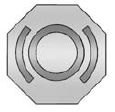Chevrolet Spark Owners Manual: Hydraulic Clutch
For vehicles with a manual transmission, it is not necessary to regularly check brake/clutch fluid unless there is a leak suspected.
Adding fluid will not correct a leak.
A fluid loss in this system could indicate a problem. Have the system inspected and repaired.
When to Check and What to Use
 The brake/hydraulic clutch fluid
The brake/hydraulic clutch fluid
reservoir cap has this symbol on it.
The common brake/clutch fluid reservoir is filled with DOT 4 brake fluid as indicated on the reservoir cap. See Engine Compartment Overview on page 10-7 for reservoir location.
How to Check and Add Fluid
Visually check the brake/clutch fluid reservoir to make sure the fluid level is at the MIN (minimum) line on the side of the reservoir. The brake/ hydraulic clutch fluid system should be closed and sealed.
Do not remove the cap to check the fluid level or to top off the fluid level.
Remove the cap only when necessary to add the proper fluid until the level reaches the MIN line.
 Manual Transmission Fluid
Manual Transmission Fluid
How to Check Manual Transmission Fluid
It is not necessary to check the manual transmission fluid level.
A transmission fluid leak is the only reason for fluid loss. If a leak occurs,
take the veh ...
 Engine Air Cleaner/Filter
Engine Air Cleaner/Filter
The engine air cleaner/filter is in the engine compartment on the driver side
of the vehicle. See Engine Compartment Overview on page 10-7 for more information
on location.
When to Inspect the En ...
Other materials:
Engine Oil
To ensure proper engine performance and long life, careful attention must be
paid to engine oil.
Following these simple, but important steps will help protect your investment:
Always use engine oil approved to the proper specification and of the proper
viscosity grade. See “Selecting the R ...
Interior Lighting
Dome Lamps
The dome lamp controls are in the overhead console.
Move the control to change the lamp setting.
OFF: Turns the lamps off, even when a door is open.
DOOR: Turns the lamps on automatically when a door is opened.
ON: Turns on the dome lamps.
For more information about interior lig ...
Floor Mats
Warning
If a floor mat is the wrong size or is not properly installed,
it can interfere with the pedals.
Interference with the pedals can cause unintended acceleration and/or increased
stopping distance which can cause a crash and injury. Make sure the floor mat does
not interfere with the p ...
